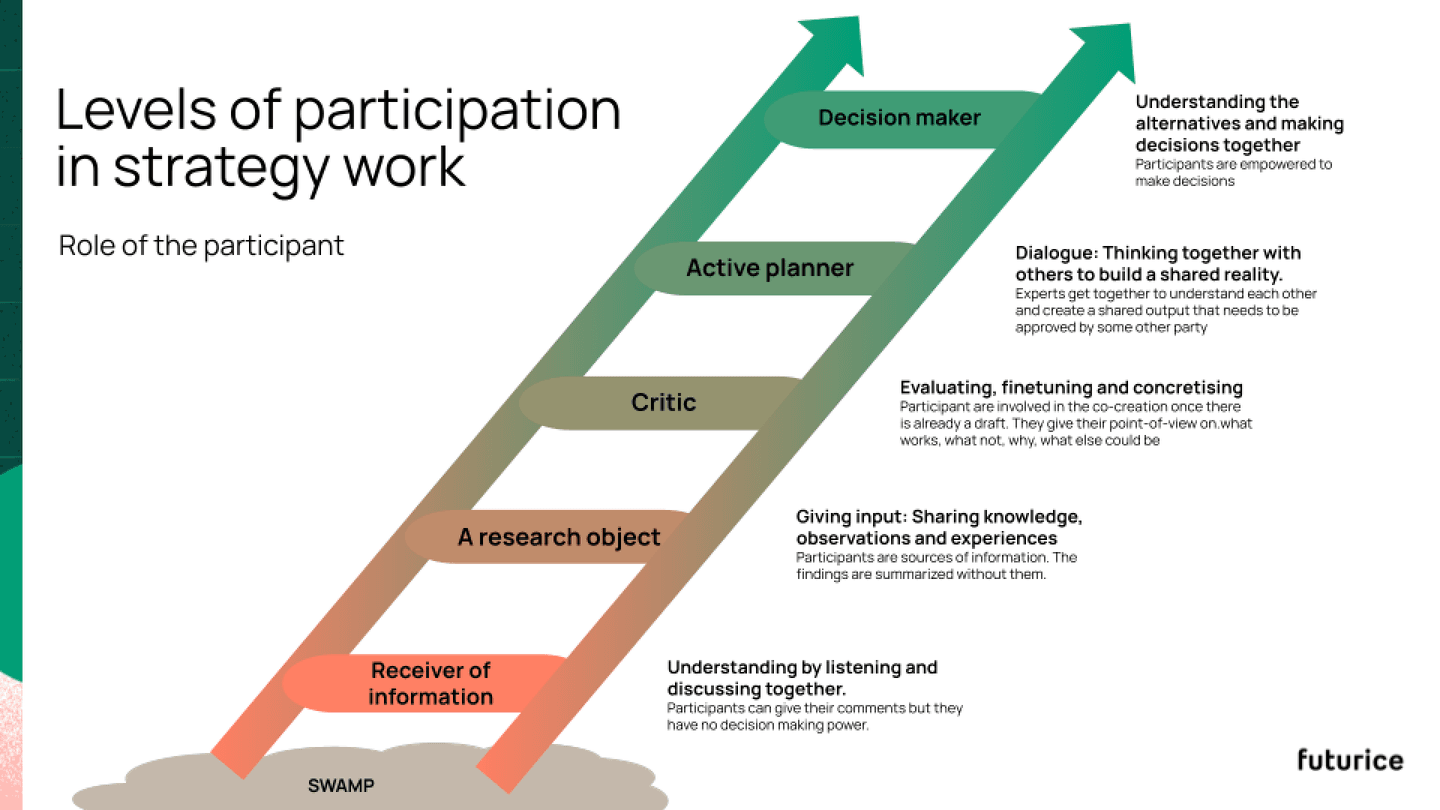How to avoid strategy potholes by engaging people
When similar inventions arise simultaneously in different areas, being the first to implement them in practice becomes increasingly important. This article outlines concrete ways of improving strategy execution by engaging your employees, partners, and customers in meaningful and effective ways at different stages of adaptively crafting and executing strategy.

Your strategy execution issues are not solved by improving deployment alone
"Once the implementation is done, I can check the box and continue working as before until the strategy process is repeated in one, three, or five years," said one somewhat cynical manager.
Implementation is the most difficult part of the traditional strategy process, partly because:
- People don’t understand the rationale behind the choices
- They don’t see the relevance of the strategy for their own work
- They are upset about not being listened to and feel no ownership of the strategy and
- The top management doesn’t have visibility into behavior change beyond financial reports, and thus can’t provide the necessary support at the right time and in the right place.
All this slows down execution. Often leadership teams have little actual data on peoples’ behavior change: Is the organization moving forward in a way that supports the strategy or not? Another typical pitfall is the lack of constant validation of the hypothesis on which the strategy is based: Does the strategy still fit? Traditional strategy execution is a top-down deployment process with a clear roadmap that is followed for the next year – or longer. After multiple communication efforts, people eventually commit to the roadmap – sometimes so thoroughly that they start resisting any attempts to change it, making adaptation difficult.
Typically, solutions to the problem of slow execution are sought at the wrong end – pushing more, offering more information sessions, and more guidance and instructions. Seeking to create a more open strategy, to begin with, might speed up execution and enhance people's ability to adapt, too. When employees are engaged in strategic analysis, the organization starts developing before launching the strategy (in the “Loppu salailulle” article in Helsingin Sanomat Visio 24.5.2023).
Find the right level of engagement
"We should involve a bigger group, but no one has the time to join," a manager said.
One event for 50 people lasting 3 hours means 150 working hours, plus the time spent on preparation. What can be achieved in that time compared to what three experts can achieve in a week? Choosing the right level of participation for each situation is time effective. Activities on all stairs in the participation ladder can be called “workshops” – that’s why it is crucial always to communicate the purpose of the workshop and define which things participants can influence and which not.
The earlier a person is involved in the project at any level, the easier it is to get them excited about the implementation phase. Consider: how motivated are you to reach goals that you’ve set for yourself vs. goals that someone else dictated to you?

Levels of involvement and the role of the participant:
- Receiver
- A research object
- Critic
- Active planner
- Decision maker
Level zero is the “swamp level”: Failing to communicate the participant’s true role can lead to false expectations. If you engage people to participate without the power to influence anything, they will know and it will backfire. After dropping to ground level, climbing up the ladder and convincing people of your genuine desire to hear their voice and empower them can be difficult. You should move up one step at a time and remember to come back to people and explain what the impact of their input was.
Tips for engaging people in an adaptive strategy work
Here are some practical examples of the wide range of options available for engaging people in different stages of strategy work.
Fair process
A healthcare organization discovered that running a fair, transparent, and interactive process that utilized inclusive working methods led to a better understanding of the background of decisions and increased people’s trust in the decision-makers. Having had the opportunity to influence the decisions, people were more likely to accept the final strategy, even if they disagree with some parts of it. A director in an industrial business said that once their strategy was crafted with a wider group of people than before, it was not questioned as strongly as before.
The strategy process must be clear, logical, and especially fair from the point of view of the various stakeholders. Fairness is about clarifying at what stage decision-making can be influenced and how – as well as what can not be influenced. When people are interviewed, they also need to know whether the information is treated anonymously or not.
Expanding personal experiences
A grocery store chain wanted their managers and directors to understand better the situation in the stores and how their operational staff see and experience things. The people drafting the strategy were instructed to visit a few stores and interview several staff members. The findings were documented on an online whiteboard later used in a workshop where the current state was discussed. It was eye-opening for the “office people”. Interviewees were delighted that there was true interest in their work and opinions because usually, they didn’t receive such attention.
Analysis together with the client
A small software company conducted a survey among its clients and then analyzed the findings together with representatives from the key customers. Initially, they were a little hesitant and assumed customers would not have the time nor interest in joining a workshop. Quite the opposite! Instead, the clients asked, “Can we send four people to your workshop?” The software company had to answer, “Sorry, we have space only for two people per organization”. Despite the initial doubts, engaging key customers in the process deepened the software company’s relationship with its customers.
Evaluation of the strategic choices
An extended team of directors of a global industrial company had mapped the current state, agreed on an ambition level and vision, and drafted strategic alternatives of “where to play” and “how to win”. Then multiple teams in different countries were asked to evaluate the drafts. This enabled an understanding of the possible negative and positive impacts of the choices from different perspectives and helped gain early buy-in. Once the extended team of directors had made the decisions, the same teams were asked to evaluate them from an execution perspective: what does the strategy mean; what needs to be changed; what new initiatives started; and what should be continued. The process of forming the strategy was both top-down and bottom-up.
Iterative roadmap and feedback loops
Typically strategy is concretized as a roadmap for a certain period of time. When you wish to increase adaptability, the items on the roadmap should be more about experimenting, exploring, and testing things instead of fixed action plans. Defining regular checkpoints is necessary to share learnings and iterate the roadmap together. You should regularly collect and connect data insights to improve actions. One company used their customer service people as “sensors”. Once a new way of working was launched, they were asked to observe what works and what didn’t.
You should build feedback loops to build-measure-learn faster and make your roadmaps more iterative.
Why do some organizations open up their strategy work and engage their employees and sometimes even their customers and partners?
Benefits
- Involving a diverse group of individuals in the strategy creation process leads to a more comprehensive examination of opportunities and challenges and helps identify potential blind spots.
- Diverse point-of-view and good facilitation improve the quality of decisions.
- Empowering people can lead to innovation and out-of-the-box thinking, helping organizations stay competitive in rapidly changing markets.
- Taking part in strategy formulation or evaluation allows individuals to understand the underlying rationale and goals of the organization, as well as realize core problems and boundaries, leading to greater buy-in and commitment to the strategy.
- Promotes a sense of ownership and accountability among stakeholders, leading to better execution and results.
- More effective communication and implementation of the strategy. Being able to contribute their skills and expertise to the organization makes employees feel valued and appreciated and has the potential to improve employee engagement and motivation.
The way to build faster response times is to start being more co-adaptive. For insight into what that means, check out these articles about focusing on the right things and co-adaptive capabilities.
If you wish to discuss further on how your organization can focus on the right things to stay competitive, write to me at piritta.vanderbeek@futurice.com.
 Piritta van der BeekPrincipal Advisor
Piritta van der BeekPrincipal Advisor





